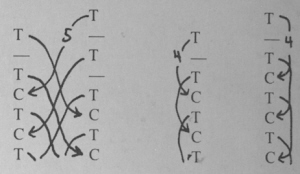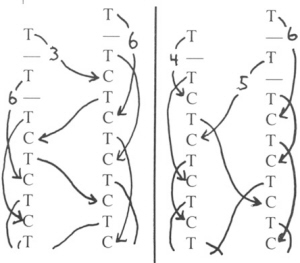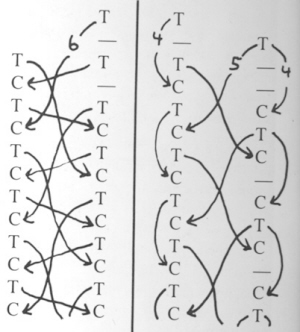
Figures 1 & 2 |
Figures 3 & 4 |

Figures 5 & 6 |
Figure 7 |

Figures 8 & 9 |
'The Monte'
|
Page 11 January 1982
|
The
following is an explanation of a method for inventing four and five
ball patterns with unusual timing. It involves making a double column
of symbols for throws and catches (a column for each hand), and
connecting the throw symbols to catch symbols to create the notation
for a juggling pattern.
The
five ball cascade is shown in figure one, and the four ball fountain
in figure two. You can tell how high a throw will be by noting how
many throws will leave the hand to which the ball is thrown before the
ball is caught. In the diagrams, a number is included in some arrows
to tell the height of the throw. e.g.. 5 means the height of throws in
a five ball cascade. Unless otherwise indicated, start, with three
balls in the right hand.
Figure
three is an easy one. Throw from the right and left hands
simultaneously, the right hand throwing at 4-heights to the left hand
and the left hand throwing a self at 6-height. Then throw a high self
with the right and a low across throw with the left, etc. The result
is a low three ball cascade with two self tosses on the sides.
Figure four is also synchronous. With the right hand, throw at 6-height to the left hand, while the left hand throws a self at 4-height, 'then switch sides. This is a high three ball cascade with two low selfs on the sides.
Figure
five is an alternating five ball pattern, a six ball fountain with two
balls being replaced by one small throw back and forth. Start with a
6height self, then a very small across throw from the left, and
another 6-height right self, then switch sides.
Figure six illustrates another alternating pattern, in which a three-and-two pattern switches right to left every third throw. Converted to four balls it becomes figure seven, which starts with two balls in each hand.
Figure
eight is a four ball shower that switches direction with every
throw. Three balls form a high cascade and the fourth is thrown
straight across back and forth.
Lastly,
figure nine describes a pretty easy five ball pattern with a
multiplex throw from the right hand. Start with three in the right
hand but make the left hand self throw first. then the multiplex
throw from the right, then the across throw from the left.
The right hand waits until the left hand makes another self throw. Use outside throws for everything in this pattern.
Two
ball backhander introduces 'The Monte'
By
Lou Carroll Brooklyn, NY
I
employ an unusual juggling variation I call the Two-Ball Monte.
(What's in a name?) There are a number of two ball novelty maneuvers,
and this is one of a series of several backhand variations I do.
Two
balls are held in the hand (fig. 1) palm up.
They
are tossed into the air at a normal juggling height (fig. 2). When
they come down, one is caught in a clawing position (fig. 3) and the
hand continues downward to snare the second ball on the back of the
hand. Done properly, both catches appear to have been made in one
swoop (fig. 4).
It's
good to develop dexterity in backhand catching of a single ball before
trying the complete trick. In figure three, note that the first,
fourth and fifth fingers are free of the first catch in order to trap
the second ball on the back of the hand. In as much as I have seen
several jugglers master some backhand catches, it is not impossible to
learn. Perseverance!
Not
satisfied with the basic move, I have furthered it by tossing the
two balls over either shoulder and under my leg. An added exhilarating
effect is to have a member of the audience toss the two balls for you
to catch.
I
find lacrosse balls too big to use in backhand juggling. For me, the
sponge rubber "pinky" balls work best. The outside surface
is rougher, permitting a surer grasp.
Jugglers
looking for new worlds to conquer should investigate the Two-Ball
Monte! |

Figures 1 & 2 |
Figures 3 & 4 |

Figures 5 & 6 |
Figure 7 |

Figures 8 & 9 |
'The Monte'
|